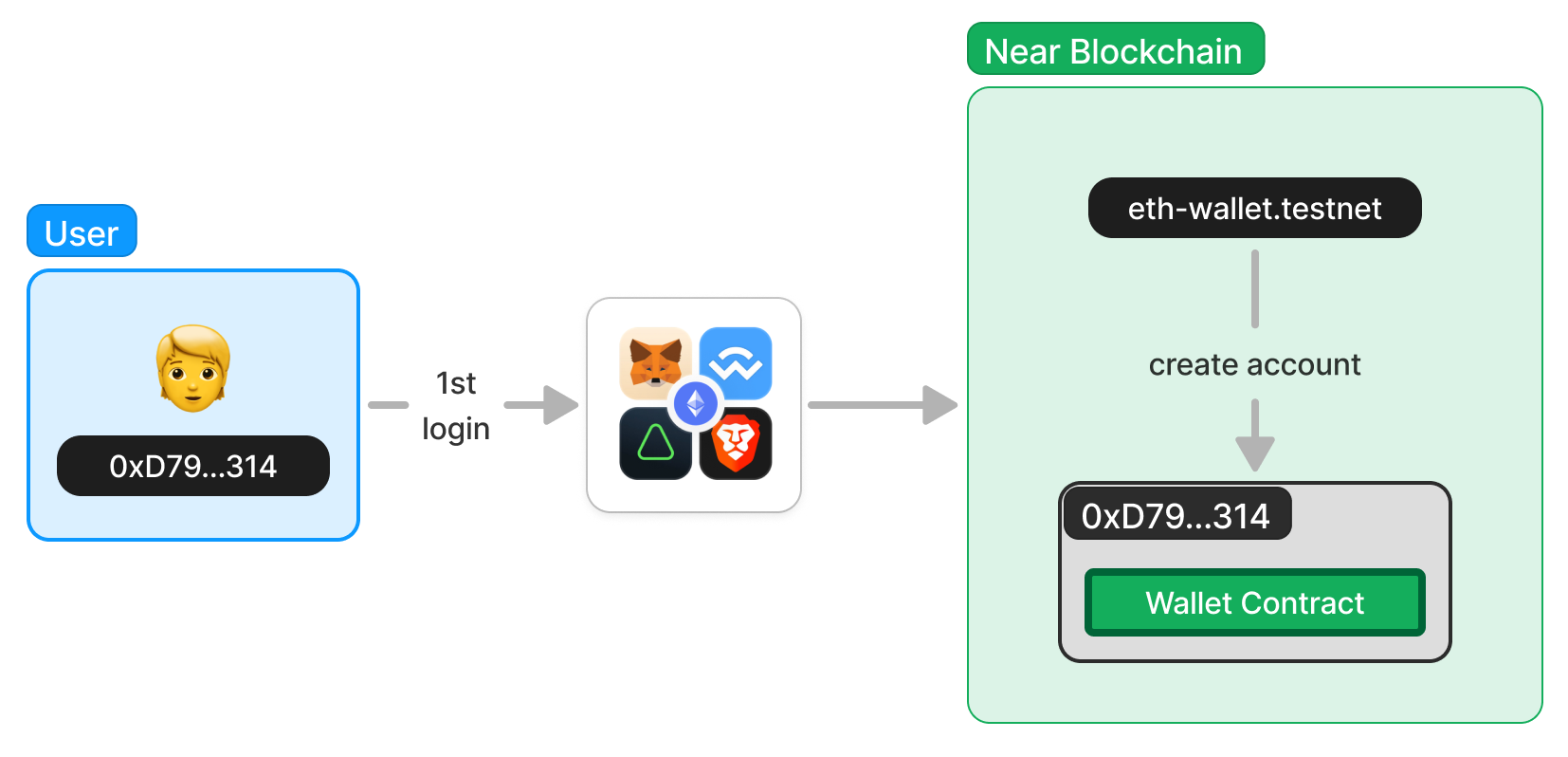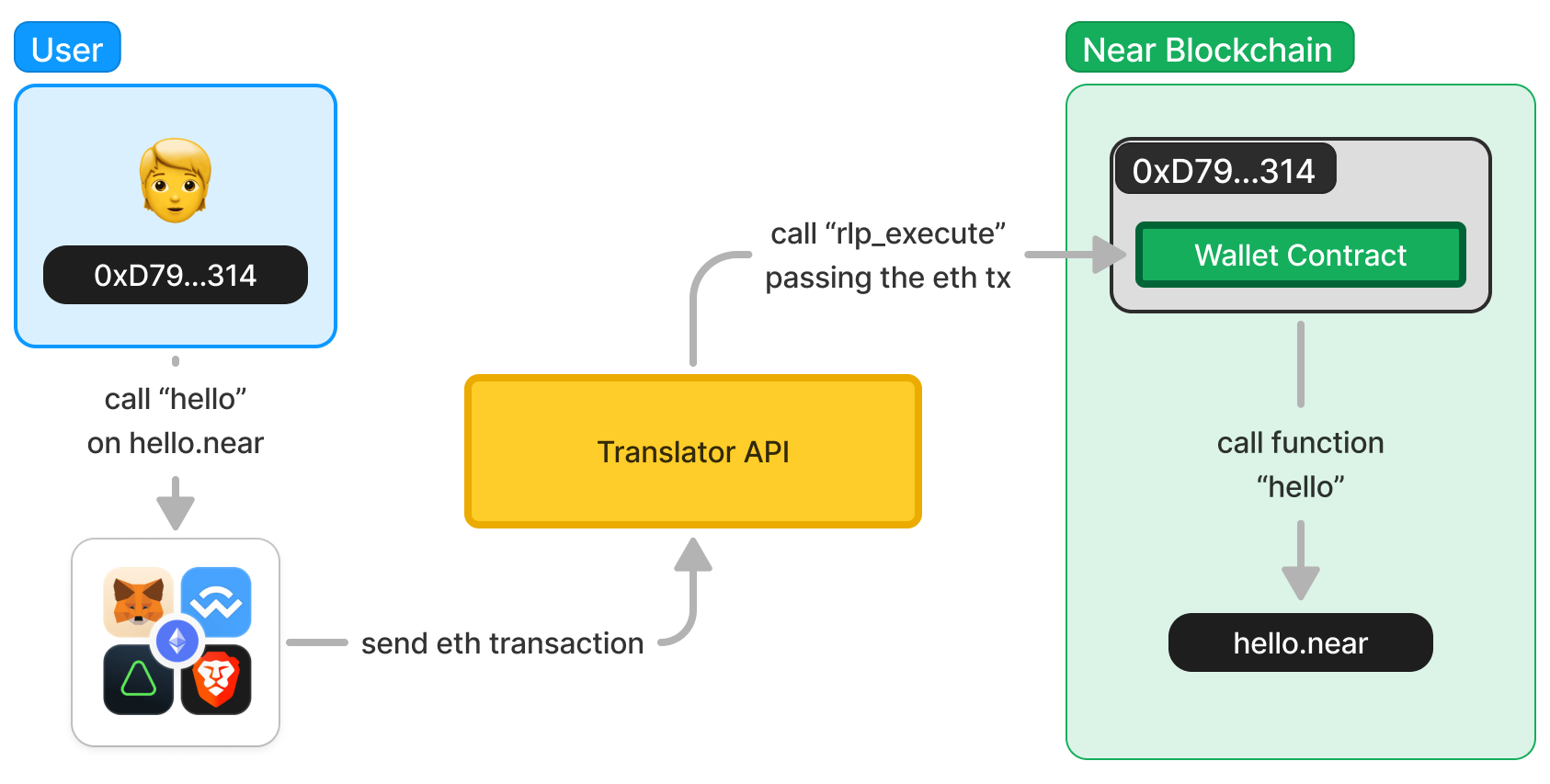EVM Wallets on NEAR
Thanks to the NEAR Wallet Selector, users can login into NEAR applications using Ethereum-compatible wallets, such as MetaMask, Trust Wallet, and others.
To make this possible, different components interact to translate Ethereum transactions into NEAR transactions, and vice-versa. Let's see how they work!
This page provides a high-level overview on how these components works, for a detailed specification please see the NEAR Enhancement Proposal (NEP-518).
Check our step-by-step tutorial on how to add Ethereum wallets support to your NEAR app using the NEAR Wallet Selector
Components Overview
Since Ethereum wallets create ethereum transactions and talk with ethereum RPCs, three components are needed to make them work on NEAR:
- A
Transaction Encoderservice, that encodes NEAR actions into Ethereum transactions - A
Translator RPCservice, that translates Ethereum RPC calls into NEAR RPC calls - A
Wallet Contractthat allows NEAR accounts to process EVM transactions

High-level architecture of Ethereum wallets on NEAR
Transaction Encoder
The Translator Encoder - implemented directly in the NEAR Wallet Selector - takes the intent of the user (e.g. call set_greeting on hello.near) and translates it into an Ethereum transaction that the EVM wallet can sign.
To (field)
The to field of the Ethereum transaction is transformed following these rules:
- If the
receiverIdmatches^0x[a-f0-9]{40}$(e.g.0xD79...314), then thetofield is set to thereceiverId - Otherwise (e.g.
ana.nearor an implicit account) thetofield is set askeccak-256(receiverId)[12,32]
Data (field)
The data field meanwhile contains the RLP-encoded NEAR actions wanted by the user, encoded as function calls on Ethereum, for example:
FunctionCall(to: string, method: string, args: bytes, yoctoNear: uint32)Transfer(to: string, yoctoNear: uint32)Stake(public_key: bytes, yoctoNear: uint32)AddKey(public_key: bytes, nonce: uint64, is_full_access: bool, allowance: uint256, receiver_id: string, method_names: string[])
For more information on how other fields (such as value, gas, and chainId) are set, please refer to the NEP-518 technical specification
Translator RPC
The Translator RPC is a service deployed at https://eth-rpc.mainnet.near.org (for mainnet) and https://eth-rpc.testnet.near.org (for testnet) that translates Ethereum RPC calls into NEAR RPC calls.
In other words, the Translator RPC simply acts as a relayer, taking the Ethereum transactions signed by the user and translating them into a function call into the Wallet Contract deployed in the user's account.
Wallet Contract
The Wallet Contract is a smart contract on NEAR that allows NEAR accounts to process EVM transactions.
The contract exposes a method called rlp_execute, which takes as argument an RLP-encoded Ethereum transaction, verifies its signature, and executes the NEAR actions encoded in the data field of the transaction.
Every NEAR account created through an EVM wallet has the Wallet Contract deployed on it.
Remember that in NEAR all accounts can have contracts, and that contracts can perform all the actions that the account can do.
How it Works?
Let's see how the components described above interact when a user logs in and uses an application.
First Time Login
The first time you login through your EVM wallet, the wallet selector will contact the account ethereum-wallets.near to create a NEAR account with the same address as your Ethereum wallet. For example, if your address on Metamask is 0xD79...314, the NEAR account created will be 0xD79...314.
On this account, the Wallet Contract is deployed and a function-call key is added for the rlp_execute function of the contract

On your first login, a NEAR accounts with the same address as your Ethereum wallet is created, and the Wallet Contract is deployed on it
Using the Account
Once you have logged in, you can start interacting with the application. If at some point the application needs to interact with the blockchain, Metamask will ask you to sign a transaction.
Under the hood, Metamask will create an Ethereum transaction and send it to the Translator API, deployed at https://eth-rpc.mainnet.near.org.
The Translator API will then translate the Ethereum transaction into a function call into the Wallet Contract deployed in your account. Particularly, it will call the rlp_execute function, passing the Ethereum transaction as an argument.

The Wallet Contract will then execute the function call, and the application will receive the result.
Resources
Check the following resources to learn more about Ethereum wallets on NEAR:
- Adding EVM Wallets to your NEAR App - Step-by-step tutorial on how to add Ethereum wallets support to your NEAR app
- NEP-518 Technical Specification - Full technical specification of how Ethereum wallets work on NEAR